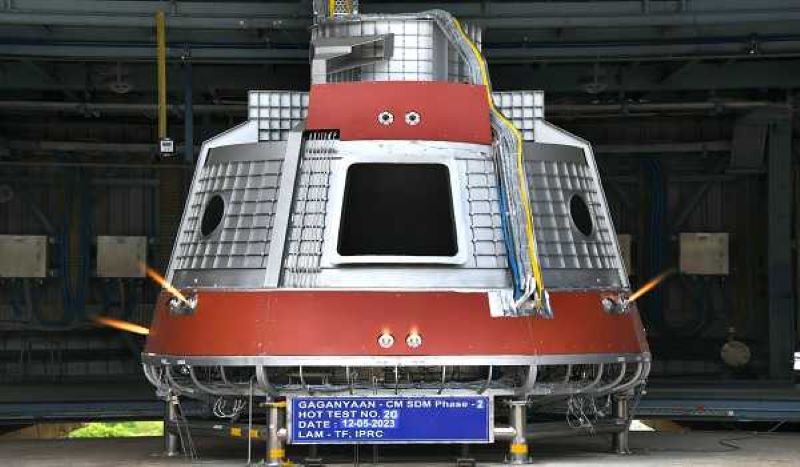 Gaganyaan
Gaganyaan
Final crew module tests for Gaganyaan mission successfully completed: ISRO
Bengaluru: ISRO on Saturday confirmed that the final test in a series of 14 tests, conducted at ISRO Propulsion Complex (IPRC), Mahendragiri in Tamil Nadu, has been completed to qualify for the Crew Module Propulsion System for the Gaganyaan Programme.
Gaganyaan mission aims to send a crew of three astronauts into low-earth orbit as part of the country's manned space flight initiative.
The test was conducted for a duration of 602.94 s and all the parameters were as expected.
"With this test, conducted yesterday, the Crew Module Propulsion System has undergone 14 tests under nominal and off-nominal conditions for a cumulative duration of 3,429 seconds," it said.
The system, consisting of 12 Nos. of 100 N thrusters and associated flow control components, will provide three-axis control to the Crew Module during re-entry i.e from an altitude of 170 km to 7 km till the deployment of the parachute-based deceleration system, it added.
The Crew Module Propulsion System was designed and developed at the Liquid Propulsion Systems Centre of ISRO and the tests were carried out in the test facility at IPRC, Mahendragiri, marking a major milestone in taking forward the prestigious mission.
Meanwhile, indigenously developed parachutes for the secure retrieval of the capsule carrying astronauts as part of the planned Gaganyaan programme, are scheduled to undergo fitting tests at an ISRO facility in Bengaluru.
The Aerial Delivery Research and Development Establishment (ADRDE), a laboratory located in Agra and operated by the Defence Research and Development Organisation (DRDO), has successfully developed parachutes for India's ambitious Gaganyaan program.
The flight unit of the parachutes, developed by ADRDE, was flagged off from Agra to the ISRO Satellite Integration and Testing Establishment in Bengaluru on Saturday. This marks an important milestone in the progress of the Gaganyaan program, bringing the crucial components closer to their integration and testing phase at ISRO's facility.
ISRO's Gaganyaan project aims to demonstrate human spaceflight capabilities by launching a three-member crew into a 400 km orbit for a three-day mission, bringing them back safely to Earth. This ambitious endeavor will use India's expertise, industry experience, academic resources, and cutting-edge international technologies.
Key prerequisites include developing critical technologies such as a human-rated launch vehicle, life support systems, crew management aspects, and safety measures.
The project will be preceded by demonstrator missions, including Integrated Air Drop Test (IADT), Pad Abort Test (PAT), and Test Vehicle (TV) flights, to ensure system reliability and safety. The GSLV-MkIII, now known as Human Rated LVM3 (HLVM3), has been identified as the launch vehicle for the Gaganyaan mission. The Orbital Module, consisting of a Crew Module and Service Module, incorporates advanced avionics systems and ensures crew safety during the mission.
The parachute configuration for the Gaganyaan program comprises a total of 10 parachutes, each serving a specific function during the flight. The sequence begins with the deployment of two "apex cover separation parachutes" that remove the protective cover from the crew module parachute compartment.
This is followed by the deployment of two "drogue parachutes" to stabilize and reduce velocity.
Support Our Journalism
We cannot do without you.. your contribution supports unbiased journalism
IBNS is not driven by any ism- not wokeism, not racism, not skewed secularism, not hyper right-wing or left liberal ideals, nor by any hardline religious beliefs or hyper nationalism. We want to serve you good old objective news, as they are. We do not judge or preach. We let people decide for themselves. We only try to present factual and well-sourced news.







